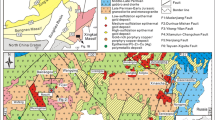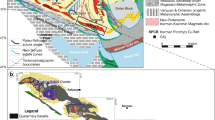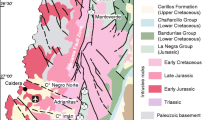Abstract
The Osborne iron oxide–copper–gold (IOCG) deposit is hosted by amphibolite facies metasedimentary rocks and associated with pegmatite sheets formed by anatexis during peak metamorphism. Eleven samples of ore-related hydrothermal quartz and two pegmatitic quartz–feldspar samples contain similarly complex fluid inclusion assemblages that include variably saline (<12–65 wt% salts) aqueous and liquid carbon dioxide varieties that are typical of IOCG mineralisation. The diverse fluid inclusion types present in each of these different samples have been investigated by neutron-activated noble gas analysis using a combination of semi-selective thermal and mechanical decrepitation techniques. Ore-related quartz contains aqueous and carbonic fluid inclusions that have similar 40Ar/36Ar values of between 300 and 2,200. The highest-salinity fluid inclusions (47–65 wt% salts) have calculated 36Ar concentrations of approximately 1–5 ppb, which are more variable than air-saturated water (ASW = 1.3–2.7 ppb). These fluid inclusions have extremely variable Br/Cl values of between 3.8 × 10−3 and 0.3 × 10−3, and I/Cl values of between 27 × 10−6 and 2.4 × 10−6 (all ratios are molar). Fluid inclusions in the two pegmatite samples have similar 40Ar/36Ar values of ≤1,700 and an overlapping range of Br/Cl and I/Cl values. High-salinity fluid inclusions in the pegmatite samples have 2.5–21 ppb 36Ar, that overlap the range determined for ore-related samples in only one case. The fluid inclusions in both sample groups have 84Kr/36Ar and 129Xe/36Ar ratios that are mainly in the range of air and air-saturated water and are similar to mid-crustal rocks and fluids from other settings. The uniformly low 40Ar/36Ar values (<2,200) and extremely variable Br/Cl and I/Cl values do not favour a singular or dominant fluid origin from basement- or mantle-derived magmatic fluids related to A-type magmatism. Instead, the data are compatible with the involvement of metamorphic fluids that have interacted with anatectic melts to variable extents. The ‘metamorphic’ fluids probably represent a mixture of (1) inherited sedimentary pore fluids and (2) locally derived metamorphic volatilisation products. The lowest Br/Cl and I/Cl values and the ultra-high salinities are most easily explained by the dissolution of evaporites. The data demonstrate that externally derived magmatic fluids are not a ubiquitous component of IOCG ore-forming systems, but are compatible with models in which IOCG mineralisation is localised at sites of mixing between fluids of different origin.









Similar content being viewed by others
References
Adshead ND (1995) Geology, alteration and geochemistry of the Osborne Cu-Au deposit, Cloncurry District, N.W. Queensland, Australia. Ph.D. thesis, James Cook University, Townsville, Australia
Adshead ND, Voulgaris P, Muscio VN (1998) Osborne copper–gold deposit. In: Berkman DA, Mackenzie DH (eds) Geology of Australian and Papua New Guinean mineral deposits. The Australasian Institute of Mining and Metallurgy, Melbourne, pp 793–800
Baker T (1996) The geology and genesis of the Eloise Cu-Au deposit, Cloncurry District, N.W. Queensland, Australia. Ph.D. thesis, James Cook University, Townsville, Australia
Baker T (1998) Alteration, mineralization, and fluid evolution at the Eloise Cu-Au deposit, Cloncurry District, northwest Queensland, Australia. Econ Geol 93:1213–1236
Ballentine CJ, Burgess R, Marty B (2002) Tracing fluid origin, transport and interaction in the crust. In: Porcelli D, Ballentine CJ, Wieler R (eds) Noble gases in geochemistry and cosmochemistry. Geochemical Society and Mineralogical Society of America, Washington, DC, pp 539–614
Barton MD, Johnson DA (1996) Evaporitic-source model for igneous-related Fe oxide-(REE-Cu-Au-U) mineralization. Geology 24:259–262
Beardsmore TJ (1992) Petrogenesis of Mount Dore-style breccia-hosted copper + gold mineralization in the Kuridala-Selwyn region of Northwestern Queensland. Ph.D. thesis, James Cook University, Townsville, Australia
Beardsmore TJ, Newbery SP, Laing W (1988) The Maronan supergroup: an inferred early volcanosedimentary rift sequence in the Mount Isa Inlier and its implications for ensialic rifting in the Middle Proterozoic of northwest Queensland. Precambrian Res 40(41):87–507
Betts PG, Giles D, Mark G, Lister GS, Goleby BR, Aillères L (2006) Synthesis of the Proterozoic evolution of the Mt Isa Inlier. Aust J Earth Sci 53:187–211
Böhlke JK, Irwin JJ (1992) Brine history indicated by argon, krypton, chlorine, bromine and iodine analyses of fluid inclusions from the Mississippi Valley type lead-fluorite-barite deposits at Hansonburg, New Mexico. Earth Planet Sci Lett 110:51–66
Davidson GJ (1989) Starra and Trough Tank: Iron formation-hosted gold-copper deposits of northwest Queensland, Australia. Ph.D. thesis, University of Tasmania, Australia
Davidson GJ, Large RR (1994) Gold Metallogeny and the Copper-Gold Association of the Australian Proterozoic. Miner Depos 29:208–223
De Jong G, Rotherham J, Phillips GN, Williams PJ (1998) Mobility of rare-earth elements and copper during shear-zone-related retrograde metamorphism. Geologie en Mijnbouw 76:311–319
Dong G (1995) Fluid inclusions from Cloncurry ore systems. In: Pollard PJ (ed) Amira P438: Cloncurry Base Metals and Gold Annual Report
Drescher J, Kirsten T, Schäfer K (1998) The rare gas inventory of the continental crust, recovered by the KTB Continental Deep Drilling Project. Earth Planet Sci Lett 154:247–263
Foster DRW, Rubenach MJ (2006) Isograd patterns and regional low-pressure, high temperature metamorphism of pelitic, mafic and calc-silicate rocks along an east–west section through the Mt Isa Inlier. Aust J Earth Sci 53:167–186
French T (1997) Genesis of albitites and anthophyllite-bearing lithologies of the Osborne Cu-Au deposit, Cloncurry District, Mount Isa Inlier, N.W. Queensland. BSc (Honours). thesis, James Cook University, Townsville, Australia
Gauthier L, Hall G, Stein H, Schaltegger U (2001) The Osborne deposit, Cloncurry district: a 1595 ma cu-au skarn deposit. In: Williams PJ (ed) A hydrothermal odyssey extended conference abstracts, Townsville, 17–19 May, pp 58–59
Giles D, Nutman AP (2002) SHRIMP U-Pb monazite dating of 1600–1580 Ma amphibolite facies metamorphism in the southeastern Mt Isa Block, Australia. Aust J Earth Sci 49:455–466
Haynes DW, Cross KC, Bills RT, Reed MK (1995) Olympic Dam ore genesis: a fluid-mixing model. Econ Geol 90:281–307
Hanor JS (1994) Origin of saline fluids in sedimentary basins. In: Parnell J (ed) Geofluids: origin, migration and evolution of fluids in sedimentary basins. Geological Society, London, pp 151–174 (Special Publication)
Hitzman MW, Oreskes N, Einaudi MT (1992) Geological characteristics and tectonic setting of Proterozoic iron oxide (Cu-U-Au-REE) deposits. Precambrian Res 58:241–287
Hohenberg CM (1967) I-Xe dating of the shallowater achondrite. Earth Planet Sci Lett 3:357–362
Hollister LS (1988) On the origin of CO2 in fluid inclusions in migmatites. J Metamorph Geol 6:467–474
Holser WT (1979) Trace elements and isotopes in evaporites. In: Burns RG (ed) Marine Minerals, Mineralogical Society of America Short Course Notes 6, pp 295–346
Johnson L, Burgess R, Turner G, Milledge JH, Harris JW (2000) Noble gas and halogen geochemistry of mantle fluids: comparison of African and Canadian diamonds. Geochim Cosmochim Acta 64:717–732
Kelley S, Turner G, Butterfield AW, Shepherd TJ (1986) The source and significance of argon isotopes in fluid inclusions from areas of mineralization. Earth Planet Sci Lett 79:303–318
Kendrick MA, Burgess R, Pattrick RAD, Turner G (2001) Fluid inclusion noble gas and halogen evidence on the origin of Cu-Porphyry mineralising fluids. Geochim Cosmochim Acta 65:2651–2668
Kendrick MA, Burgess R, Pattrick RAD, Turner G (2002) Hydrothermal fluid origins in a fluorite-rich Mississippi Valley-type deposit: combined noble gas (He,Ar,Kr) and halogen (Cl,Br,I) analysis of fluid inclusions from the South Pennine Orefield, United Kingdom. Econ Geol 97:35–451
Kendrick MA, Phillips D, Miller JM (2006a) Part I. Decrepitation and degassing behaviour of quartz up to 1560°C: analysis of noble gases and halogens in complex fluid inclusion assemblages. Geochim Cosmochim Acta 70:2540–2561
Kendrick MA, Duncan R, Phillips D (2006b) Noble gas and halogen constraints on mineralising fluids of metamorphic versus surficial origin: Mt Isa, Australia. Chem Geol 235:325–351
Kendrick MA, Mark G, Phillips D (2007) Mid-crustal fluid mixing in a Proterozoic Fe oxide-Cu-Au deposit, Ernest Henry, Australia: evidence from Ar, Kr, Xe, Cl, Br, I. Earth Planet Sci Lett DOI 10.1016/j.epsl.2006.12.032
Kendrick MA, Baker T, Fu B, Phillips D, Williams PJ (2008) Noble gas and halogen constraints on regionally extensive mid-crustal Na-Ca metasomatism, the Proterozoic Eastern Mount Isa Block, Australia. Precambrian Res (in press)
Kerkhof A, Van den Thiéry R (2001) Carbonic inclusions. Lithos 55:49–68
McDougall I, Harrison TM (1999) Geochronology and thermochronology by the 40Ar/39Ar Method. Oxford University Press, Oxford
Mark G, Phillips GN, Pollard PJ (1998) Highly selective partial melting of pelitic gneiss in Cannington, Cloncurry district, Queensland. Aust J Earth Sci 45:169–176
Mark G, Oliver NHS, Carew M (2006) Insights into the genesis and diversity of epigenetic Cu-Au mineralisation in the Cloncurry district, Mt Isa Inlier, northwest Queensland. Aust J Earth Sci 53:109–124
Mora CI, Valley JW (1989) Halogen-rich scapolite and biotite: implications for metamorphic fluid–rock interaction. Am Mineral 74:721–737
Morrison G (2005) The Claytons granite model for the Osborne Cu-Au deposit: partial melting as a mineralizing process. In: Structure, Tectonics and Ore Mineralising Processes Abstract Volume, EGRU Contribution 64, pp. 93
O’Dea MG, Lister GS, MacCready T, Betts PG, Oliver NHS, Pound KS, Huang W, Valenta RK (1997) Geodynamic evolution of the Proterozoic Mount Isa terrain. In: Burg JP, Ford M (eds) Orogeny through Time. Geological Society, London, pp 99–122
Oliver NHS, Cartwright I, Wall VJ, Golding SD (1993) The stable isotope signature of kilometre-scale fracture-dominated metamorphic fluid pathways, Mary Kathleen, Australia. J Metamorph Geol 11:705–720
O’Nions RK, Ballentine CJ (1993) Rare gas studies of basin scale fluid movement. Philos Trans R Soc Lond Ser A 344:141–156
Ozima M, Podosek FA (2002) Noble gas geochemistry. Cambridge University Press, Cambridge
Page RW, Sun SS (1998) Aspects of geochronology and crustal evolution in the Eastern Fold Belt, Mt Isa Inlier. Aust J Earth Sci 45:343–361
Perkins C, Wyborn LAI (1998) Age of Cu-Au mineralisation, Cloncurry district, eastern Mt Isa Inlier, Queensland, as determined by Ar-40/Ar-39 dating. Aust J Earth Sci 45:233–246
Perring CS, Pollard PJ, Dong G, Nunn AJ, Blake KL (2000) The Lightning creek sill complex, Cloncurry district, northwest Queensland: a source of fluids for Fe oxide Cu-Au mineralisation and sodic-calcic alteration. Econ Geol 95:1067–1089
Pollard PJ (2000) Evidence of a magmatic fluid and metal source for Fe-oxide Cu-Au mineralisation. In: Porter TM (ed) Hydrothermal iron oxide copper gold & related deposits: a global perspective. PGC Publishing, Adelaide, pp 27–41
Pollard PJ (2001) Sodic(-calcic) alteration in Feoxide-Cu-Au districts: an origin via unmixing of magmatic H2O-CO2-NaCl + CaCl2-KCl fluids. Miner Depos 36:93–100
Pollard PJ (2006) An intrusion-related origin for Cu-Au mineralisation in iron-oxide-copper-gold (IOCG) provinces. Miner Depos 41:179–187
Roddick JC (1983) High precision intercalibration of 40Ar-39Ar standards. Geochim Cosmochim Acta 47:887–898
Rotherham JF (1997) A metasomatic origin for the iron-oxide Au-Cu Starra orebodies, Eastern Fold Belt, Mount Isa Inlier. Miner Depos 32:205–218
Rubenach MJ, Adshead ND, Oliver NHS, Tullemans F, Esser D, Stein H (2001) The Osborne Cu-Au deposit: geochronology, and genesis of mineralization in relation to host albitites and ironstones. In: Williams PJ (ed) A hydrothermal odyssey, new developments in metalliferous hydrothermal systems research. EGRU Contribution 59, pp 172–173
Rubenach MJ, Foster DRW, Evins PM, Blake KL, Fanning CM (2008) Age constraints on the tectonothermal evolution of the Selwyn Zone, Eastern Fold Belt, Mount Isa Inlier. Precambrian Res (in press)
Spikings RA, Foster DA, Kohn BP, Lister GS (2001) Post-orogenic (<1500 Ma) thermal history of the Proterozoic Eastern Fold Belt, Mt Isa Inlier, Australia. Precambrian Res 109:103–144
Tolstikhin I, Lehmann BE, Loosli HH, Gautschi A (1996) Helium and argon isotopes in rocks, minerals, and related groundwaters: A case study in northern Switzerland. Geochim Cosmochim Acta 60:1497–1514
Torgersen T, Kennedy BM, Hiyagon H, Chiou KY, Reynolds JH, Clarke WB (1989) Argon accumulation and the crustal degassing flux of 40Ar in the Great Artesian Basin, Australia. Earth Planet Sci Lett 92:43–56
Tullemans FJ, Agnew P, Voulgaris P (2001) The role of geology and exploration within the mining cycle at the Osborne mine, NW Queensland. In: Edwards AC (ed) Mineral resources and ore estimation—the AusIMM guide to good practice. Australasian Institute of Mining and Metallurgy, Melbourne, pp 157–168
Turner G, Bannon MP (1992) Argon isotope geochemistry of inclusion fluids from granite-associated mineral veins in southwest and northeast England. Geochim Cosmochim Acta 56:227–243
Williams PJ (1994) Iron mobility during synmetamorphic alteration in the Selwyn range area, NW Queenland—implications for the origin of ironstone-hosted Au-Cu deposits. Miner Depos 29:250–260
Williams PJ, Barton MD, Johnson DA, Fontbonte L, de Haller A, Mark G, Oliver NHS, Marschik R (2005) Iron oxide copper-gold deposits; geology, space–time distribution, and possible modes of origin. In: Hedenquist JW, Thompson JFH, Goldfarb RJ, Richards JP (eds) Economic Geology, 100th anniversary volume, 1905–2005. Society of Economic Geologists, USA, pp 371–405
Worden RH (1996) Controls on halogen concentrations in sedimentary formation waters. Mineral Mag 60:259–274
Wyborn LAI (1998) Younger ca 1500 Ma granites of the Williams and Naraku Batholiths, Cloncurry district, eastern Mt Isa Inlier: geochemistry, origin, metallogenic significance and exploration indicators. Aust J Earth Sci 45:397–411
Yardley BWD, Graham JT (2002) The origins of salinity in metamorphic fluids. Geofluids 2:249–256
Zherebtsova IK, Volkova NN (1966) Experimental study of behaviour of trace elements in the process of natural solar evaporation of Black Sea Water and Lake Sasky-Sivash brine. Geochem Int 3:656–670
Acknowledgements
This work was funded by the predictive mineral discovery Cooperative Research Centre (pmd*CRC) and is published with permission. Louise Fisher’s Ph.D. work was supported by an International Postgraduate Research Scholarship. Barrick Gold and Osborne Mine provided access to the mine data and samples collected by Roger Mustard. Mine geologist Britt Kuhneman is thanked for the advice on sample context and Stanislav Szczepanski is gratefully acknowledged for the technical assistance in the lab.
Author information
Authors and Affiliations
Corresponding author
Additional information
Editorial handling: B. Lehmann
Electronic supplementary material
The full data set is available electronically in the excel appendix.
Below are the links to the electronic supplementary material.
ESM Table 1
Irradiated samples—data summarised in Table 3 (XLSX 62 KB)
ESM Table 2
Unirradiated samples—F values summarised in Table 3 (XLSX 15 KB)
ESM Table 3
Typical blanks or detection limits (XLSX 12 KB)
Rights and permissions
About this article
Cite this article
Fisher, L.A., Kendrick, M.A. Metamorphic fluid origins in the Osborne Fe oxide–Cu–Au deposit, Australia: evidence from noble gases and halogens. Miner Deposita 43, 483–497 (2008). https://doi.org/10.1007/s00126-008-0178-2
Received:
Accepted:
Published:
Issue Date:
DOI: https://doi.org/10.1007/s00126-008-0178-2




